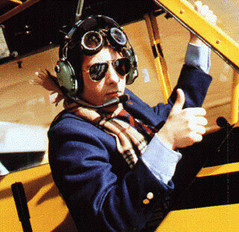Review: "Kill Bill Vol. 2"
Starring Uma Thurman, David Carradine, Michael Madsen, Daryl Hannah; written and directed by Quentin Tarantino
(Rated R for violence, language and brief drug use)
3 stars (out of 4)
"Tarantino's derivative," Mike said to Rob in Swingers (1996) as they sat around playing cards. Shortly thereafter, they and their friends walked down an alley in choppy slow motion, a nod of grudging respect to Reservoir Dogs (1992), the film that put Quentin Tarantino on the festival and cultural map. The point? Imitation is the sincerest way to disguise plagiarism, or something like that.
The first volume of Quentin Tarantino's fourth film, Kill Bill, ended with an orgy of bloodletting by the Bride (Uma Thurman), followed by Bill's teaser: "Does she know her daughter is still alive?" Most of this has been forgotten in the interim, though, something Tarantino is probably counting on: although the second half of a larger story, Kill Bill: Vol. 2 does its best to stand out as a film in its own right. That it succeeds as much as it does is to Tarantino's credit-when making one film into more without compromising the story, it's easy to miss the mark, as Peter Jackson and the Wachowski brothers could no doubt woefully attest.
Less violent than its predecessor, though that isn't saying much, Kill Bill: Vol. 2 shows us the story of the Bride before the events of the first film mingled with her march toward the inevitable: to kill Bill (duh).
When last we left our bloodthirsty heroine, she had dispatched two of the four members of ex-boss (and old lover) Bill's Deadly Viper Assassination Squad. Remaining are Bill's brother Budd (Michael Madsen) and Elle Driver (Daryl Hannah), but if you think the heroine of a martial arts flick is going to be stopped before meeting her main enemy, you're beyond my help.
True to form, Tarantino doesn't tell the story chronologically: after confronting Budd and suffering initial defeat, we flash back to the Bride's training under Kung Fu master Pai Mei (Gordon Liu). Using a grainier film stock and plenty of zoom shots, the training sequences are Tarantino's ultimate ode to the martial arts films he grew up on and which have so strongly influenced his style. The corniness holds all the way down to Pai Mei's subtitled dialogue, including his taunt to the Bride: "Let's see your Tiger Crane match my Eagle's Claw!" I didn't know whether to laugh at the false weight of the moment or fall prostrate before the master; it's obvious what Tarantino did.
The Bride, whose name was bleeped out (for suspense?) in the first film, has her identity revealed here, and I won't spoil it except to say that the discovered wordplay isn't worth the wait. I would've preferred the constant anonymity of a nameless heroine to the almost arbitrary decision to let the secret out.
I will say that Tarantino's getting soft in his old age, though. The man who saw fit to annihilate Vincent Vega now plays the family card by exalting the Bride as mother of 4-year-old daughter B.B., who the Bride assumed had died during her coma.
Vol. 1 was devoid of any strong men, and the few here are emasculated right out of the story by our heroine on her way to her goal: not revenge, but motherhood. Tarantino has made the ultimate woman's picture, or at least ultimate for him, with mommy dearest wielding cold steel against any archetypal male villain (and there are plenty of these) who would stand against her.
Perhaps splitting the film into two volumes benefits the larger story: while a sudden gearshift halfway through a 3-hour epic might seem confusing, the division between the first, mindlessly bloody half and the slower, often more experimental second one saves the day.
Cutting any other film into two parts might have hurt it; after all, you can shear a sheep many times but slice him up with a Hattori Tanzo sword only once. While the first film has the advantage of surprise, people know what to expect in the second and are not as easily fooled (again, talk to the Wachowskis). But Tarantino sidesteps that problem by being himself and telling a pointless story with enough style to counteract its inherent inexistence.
The myriad of typefaces used in the multiple versions of the credits, the intentional placement of the Bride in a stationary car with the background projected on a screen and the downright silliness of the dialogue are indicative of a man who loves movies above all. Don't forget that Tarantino opened the whole show with: "Revenge is a dish best served cold," cited as an "old Klingon proverb." The entire film, like his others, is an exercise in taking small pieces of other works and reassembling them as his own.
But, as Rob later pointed out to Mike, "Everybody steals from everybody. I mean, that's show business." Something Tarantino took to heart.

